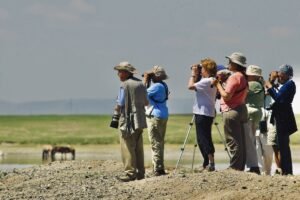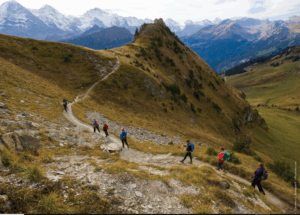Nepal and International Tourism
-Ramesh Tiwari
Tourism has emerged as the largest service industry in terms of gross revenue and foreign exchange earnings in the world. The present annual global income from tourism (international and domestic) is nearly US$13 trillion, an amount more than the GNP of all countries except the United States. A total of 212 million persons are now being employed worldwide through direct and indirect opportunities generated by the industry. It means that out of every nine persons, one person earns a living from tourism. The most significant feature of the tourism industry is the capacity to generate employment opportunities in rural areas as well contributing a lot for poverty reduction in the least-developed and developing countries.
The contribution of tourism to economic activity worldwide is estimated approximately 5% whereas tourism’s contribution to employment is considered as 6-7% of the overall number of jobs worldwide. International tourism arrivals has expanded at an annual rate of 6.2%, growing from 25 million in 1950 to 940 million in 2010.Similarly,the income generated by tourist arrivals grew at an even stronger rate reaching around US$ 919 billion in 2010.
Tourism is therefore considered an important sector for intensive development in all parts of the globe. Tourism is a composite of all activities, services, and industries that delivers a travel experience, namely transportation, accommodations, eating and drinking establishments, shops, entertainment, activity facilities, and other hospitality services available for individuals or groups that are travelling away from home. Academicians define tourism as the sum of the phenomena and relationships arising from the interaction of tourists, business suppliers, host governments and communities in the process of attracting and hosting the visitors. Tourism has experienced continued growth and diversification to become one of the fastest growing economic sectors in the world.
International tourism will continue to expand during the period 2010-2030 and the arrivals are expected to reach 1.8 billion by 2030. It means that an average 43 million additional tourists will join the tourism market for travel, leisure, business and other purposes each year, UNWTO study says. A large proportion of the arrivals of the next two decades will originate from the countries of Asia and the Pacific generating an average 17 million additional international arrivals every year. Europe will follow with an average 16 million extra arrivals a year and the remaining 10 million additional yearly arrivals from the Americas, Africa and the Middle East.
In this world scenario, tourism is thriving in South Asia as well with more tourists visiting to its vast array of natural, cultural and historic attractions. The international visitor arrivals have increased in South Asian countries in 2011. This growth in arrivals is expected to continue as tourism infrastructure and services are upgraded in the region. The development of cross border tourism is an important priority for Bhutan, Nepal, Sri Lanka, India and Bangladesh under the South Asia Sub -regional Economic Cooperation (SASEC) program. The Asian Development Bank (ADB) has contributed in developing a cross border tourism action plan for SASEC, principles for managing tourism heritage sites, planning sustainable cross border tourism circuits, marketing destinations, and strengthening human resources for tourism development.
Thus emerging destinations in Asia and the Pacific, Africa and Middle East have been the main growth drivers in international travel trade. South Asian countries-Nepal, India, Pakistan, Bangladesh, Maldives, Sri Lanka and Bhutan-hold only one percent of the world tourism market and nearly 6 million tourists visit South Asia each year. South Asia’s diversity of mountains, beaches, wildlife, natural parks provide opportunities for pursuing adventure sports like white water rafting, hot air ballooning, paragliding, skiing, mountain biking, rock climbing and trekking etc. Nevertheless South Asia has become the unsung tourist destination in the international tourism market despite political commitment of tourism development by the member countries of South Asian Association for Regional Cooperation (SAARC).
Similarly ,the Greater Mekong Sub- region (GMS) ,which includes- Cambodia, the People’s Republic of China (PRC, specifically Yunnan Province and Guangxi Zhuang Autonomous Region), Lao People’s Democratic Republic, Myanmar, Thailand, and Vietnam has planned for a sustainable development of the region as announced in the ASEAN Tourism Forum in 2011. GMS countries have committed to intensify efforts to protect natural and cultural tourism sites, upgrade infrastructure, strengthen human resources and streamline immigration procedures. Annual international tourist arrivals in the sub-region have more than doubled from 10 million in 1995 to over 26 million in 2009. In 2011 the GMS expects 30 million international arrivals due to improving economic conditions and its attractions.
In context to Nepal, the tourism scenario is not encouraging in terms of international tourist arrivals and revenue. Tourism contribution to GDP is 3.42 percent and it accounted for about 24 per cent of total foreign exchange earnings in recent years. Though Nepal’s share in world tourism market is about 0.40 percent and lowest per capita tourist earning in South Asia, she has enormous opportunities for development and expansion of tourism industry, one of the mainstay of Nepalese economy.
Nepal, home to eight of the world’s 14 highest mountains including Mount Everest, is popular all over the world as an adventure tourist destination offering activities like mountaineering, trekking, rafting and jungle safaris. Most of the tourists visit Nepal for recreation, trekking and mountaineering, business, official visit, pilgrimage, and other purposes each year. Nepal is enlisted in international media as one of major tourist destination of the world in recent years, but the tourist arrival figure is not so significant compared to other destinations of Southeast Asia. Negative publicity due to one decade long Maoist insurgency, conflict, violence, political instability, deteriorating law and order situation, adverse travel advisories and other social issues had eroded destination image of Nepal. The armed conflict in the country caused decline in tourist arrivals in the first five years of this decade. But with the end of conflict and signing of Comprehensive Peace Accord (CPA) between the Nepal government and the Nepal Communist Party (Maoist) on Nov 21, 2006, the tourism industry is slowly coming back to normalcy. The number of tourists visiting Nepal has increased continuously after implementation of peace process. At present , tourism development has become a common agenda of all the political parties, which are committed for establishment of a New Nepal.
Nepal had marked 1998 as Visit Nepal Year (VNY) to reposition Nepal’s image in international arena. The main objectives of VNY 1998 were – to increase tourist arrival up to 500 thousand, to increase average duration of tourists’ stay from 11.5 in 1995 to 13 days and increase per tourist spending from US $ 43 to US $ 50 in 1998. However, VNY could not meet the target of welcoming 500 thousand tourists but the year played a significant role to popularize positive image of Nepal in the world market besides creating awareness for the growth of domestic tourism in the country. The number of tourist arrival reached 463684 in 1998 despite Maoist insurgency and political chaos, where as Nepal received maximum number of tourists in 1999 (491504). The number of tourists visiting Nepal started to decline in the early years of 21st century .
According to Nepal Tourism Board (NTB) 463000 tourists had visited Nepal in 2000, which declined to 361,237 in 2001 and 275468 in 2002. The tourist arrival figure was 338,132 in 2003, 385297 in 2004, 375398 in 2005 and 383926 in 2006. The decline in tourist arrivals compelled many tourism entrepreneurs and hoteliers to close their business in recent years. The hotels, with a capacity of providing hospitality to about one million tourists a year had to face serious challenges to run their business during the period from 2000 to 2006. Internal conflict, insecurity, problem of air seats and accessibility, frequent Nepal bandhas and strikes, cut-throat competition among the travel entrepreneurs to cut the prices, lack of effective crisis management strategy and apathy of the government and NTB were major causes dwindling tourism industry.
The scenario has started to change now due to various socio-political reasons, mainly ongoing peace process and increased air connectivity with traditional and new destinations. Tourist arrivals created a historic record in 2007, exceeding 500,000 tourists visiting through air and land routes and the arrivals is in growing trend in 2008,2009 and 2010.The hotel occupancy has stepped up to 95 percent in recent months owing to increased tourist arrivals. The new political development and peace initiatives have given immense hope for development of tourism sector. As different international airlines have started their flights to Nepal in recent years, the tourist arrival has increased from both new and all value markets. Nepal has so far made air service agreements with 35 countries and regions of the world. In spite of increased air connectivity, efforts should be made to strengthen national carrier Nepal Airlines Corporation and start air service from Nepal to major destinations in the world tourism market including USA, Europe and Australia. It is necessary to improve physical infrastructures of the Tribhuwan International Airport and build new international airports to increase the tourist arrivals as soon as possible.
While more airlines are flying to Nepal, capacity of the Tribhuvan International Airport should be enhanced to cater the needs of tourists and improve Nepal’s image in the eyes of travelers. The facilities at the airport are horribly poor and the tourists have had to face harassments from the drivers, porters and brokers. Until and unless, the Nepal Government could improve 4T’s- toilet, telephone , taxi, and trolley facilities at the airport, the image of Nepal will be like a ‘new wine in old bottle’ despite different brands and campaigns initiated by the government .
Nepalese tourism sector has experienced a lot from the Visit Nepal Year 1998, Destination Nepal Campaign 2002/2003 and Nepal Tourism Year -2011 to make Nepal a holiday destination. Besides Nepal’s new destination brand “Naturally Nepal…. Once is not enough”, NTB along with NRN diaspora and Nepalese diplomatic missions abroad are promoting campaigns to attract more tourists. The promotional campaigns will have positive impact in rejuvenating tourism sector in the years ahead, but increased marketing budget should be allocated for well- planned international promotional campaigns in world tourism market. The success of these new campaigns depend on solution of problems such as infrastructure development , air accessibility, connectivity, product diversification, new concepts and strategies for marketing and promotion , commitment of the government, vision of NTB and collective efforts of private and public sector tourism stakeholders .
Impressed by the success of Visit Nepal Year, the government along with the private sector and NTB have launched various promotional campaigns during Nepal Tourism Year – 2011with the objective of welcoming a million tourists each year, promoting Nepal as a safe destination and making tourism a catalyst for socio- economic transformation of the country. .The total arrivals in the first 10 months of Nepal Tourism Year – 2011 have increased by 21.7 percent to 443,108. A total of 121,962 Indian tourists visited Nepal during the first 10 months of 2011, whereas as the number of Chinese tourists during the period stood at 34,897. The Incredible India Campaign has helped attract nearly 4.4 million inbound tourists a year, while another neighboring country China welcomes nearly 57 million tourists every year. These two big Asian markets have flourished in terms of international tourist arrivals and revenue in recent years. Against this background, Nepal should move ahead with long-term plan to lure large number of tourists both from two neighboring countries India and China.
As Nepal is a multi-ethnic, multi-cultural, multi-religious country inhabited by diverse 102 ethnic communities with 92 language and nine religions from the Himalayan to Terai regions, tourism development could transform life of the people living in different parts of the country. The vibrant tourism sector, employing thousands of people in the tourist areas, provides opportunities to the rural populace to achieve higher standard of living contributing to sustainable and equitable development of the regions. If more investments are made to diversity the tourism sector, a highest employment generation and forex earning trade, in potential areas, it will greatly contribute in poverty alleviation as well.
As earlier mentioned, Nepal has entered a new era after restoration of peace in the country, though Nepal has to face challenges in the transitional phase of Nepali politics. The present rising trend in tourist arrivals should be maintained consolidating peace process in the days ahead, so that Nepal could be a major destination in South Asia. Since Nepal’s post conflict tourism agenda are: promote Nepal’s tourism brand and reposition of image as a ‘safe destination’, attract maximum international tourists, quality services and products in competitive price and achieve goals of sustainable tourism, tourism should be accorded high priority as a national industry. A well planned strategy should be launched to enhance Nepal’s international image as a premier and round- the – year destination. More tourism friendly policies and programs should be formulated rather than making slogans and commitments on the part of the government.
The government should focus on regaining lost confidence of tourists through effective marketing – declaring tourism as a national industry, enhancing competitive strength of tourism entrepreneurs, operating direct air links with potential tourist generating markets, strengthening national carrier, development of tourism infrastructures, improvement in electricity supplies and communication facilities and huge investment in rural development. Nepal should also be promoted as a MICE (Meeting, Incentives, Conferences and Exhibitions) destination to tap the $ 280-billion global MICE market. These initiatives will make Nepal a major tourist destination in the years ahead and Nepal could be in a position to welcome one million tourists each year. New vision and implementation of long-term plans and programs and cooperation between the public and private sector for tourism development will surely change tourism scenario of Nepal in future. Nepal’s image should be changed from a cheap destination to a ‘quality destination’. Political stability, commitment to develop tourism and public-private partnership is the prerequisites for overall development of tourism in Federal Democratic Republic of Nepal.














